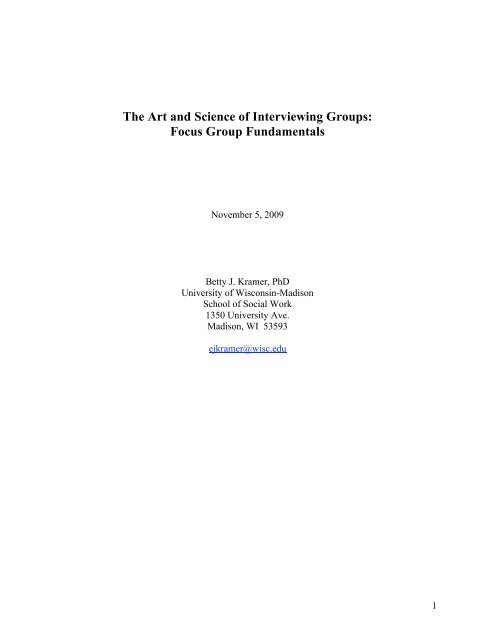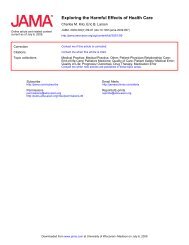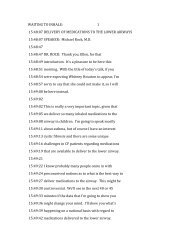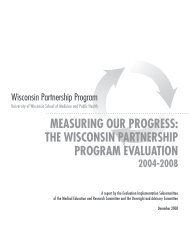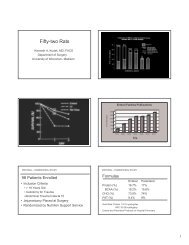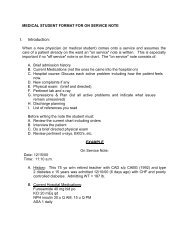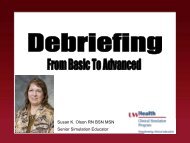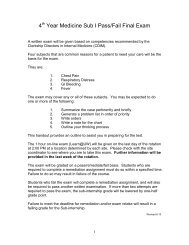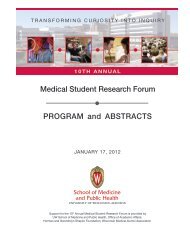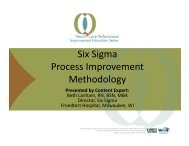The Art and Science of Interviewing Groups: Focus Group ...
The Art and Science of Interviewing Groups: Focus Group ...
The Art and Science of Interviewing Groups: Focus Group ...
Create successful ePaper yourself
Turn your PDF publications into a flip-book with our unique Google optimized e-Paper software.
<strong>The</strong> <strong>Art</strong> <strong>and</strong> <strong>Science</strong> <strong>of</strong> <strong>Interviewing</strong> <strong><strong>Group</strong>s</strong>:<strong>Focus</strong> <strong>Group</strong> FundamentalsNovember 5, 2009Betty J. Kramer, PhDUniversity <strong>of</strong> Wisconsin-MadisonSchool <strong>of</strong> Social Work1350 University Ave.Madison, WI 53593ejkramer@wisc.edu1
Designing the Interview Guide: AskingQuestions that Yield Powerful Information1. Use open-ended questionsWhat did you think <strong>of</strong> the program?How did you feel about the conference?Where do you get new information?What do you like best about the proposed program?Be cautious <strong>of</strong> phrases such as "how satisfied" or "towhat extent"2. Avoid dichotomous questions<strong>The</strong>se are questions that can be answered with a yes orno.3. "Why?" is rarely askedMay stimulate a defensive responseWhen you ask “why,” people usually respond withattributes or influences. Better to ask what contributedto…what features did you like . . .?4. Use "think back" questions.Take people back to an experience <strong>and</strong> not forward to thefuture.5. Carefully prepare focus questionsIdentify potential questions: Five Types <strong>of</strong> Questions1. Opening Question (round robin)2. Introductory Question3. Transition Questions4. Key Questions5. Ending Questions (see examples below <strong>and</strong> in textbox)All things considered question: This question asksparticipants to reflect on the entire discussion <strong>and</strong> then <strong>of</strong>fer theiropinions on topics <strong>of</strong> central importance to the researchers.Example: "Suppose that you had one minute to talk to thePresident about health care, the topic <strong>of</strong> today's discussion. Whatwould you say?"Summary question: After the brief oral summary, ask:"Is this an adequate summary?"Final question: <strong>The</strong> moderator reviews the purpose <strong>of</strong>the study <strong>and</strong> then asks: "Have we missed anything?"6. Ask uncued questions first, cued questions secondCues are the hints or prompts that help participants recallspecific features or details.7. Consider write down exercises or st<strong>and</strong>ardized questionsSentence completion, conceptual mapping8. <strong>Focus</strong> the questions.Sequence that goes from general to specific9. Be cautious <strong>of</strong> serendipitous questionsConsider but be cautious <strong>of</strong> these. Often best to save forlast.SAMPLE QUESTIONING GUIDEThis questioning route is used in focus groupswith parents who have recently been involvedwith an intensive family therapy program.Opening:1. Tell us your name <strong>and</strong> tell us howlong you have been working with(name <strong>of</strong> program.).Introductory:2. How did you learn about theservice?Transition:3. Think back to when you firstbecame involved with theseservices. What were your firstimpressions?4. What was the start up process likefor you?Key Questions:5. What was particularly helpfulabout the services you received?6. What was particularly frustratingabout the services?7. Is your child any different becausehe/she received these services? Ifso, how?8. Is your family life any differentbecause you received theseservices? If so, how?Ending Questions:9. If you had a chance to give adviceto the director <strong>of</strong> this program,what advice would you give?10. We want you to help us evaluatethese services. We want to knowhow to improve the service <strong>and</strong>what difference the service makesto families. Is there anything thatwe missed? Is there anything youthat came to say that you didn’tget a chance to say?(Krueger & Casey, 2009)2
Setting the Scene:St<strong>and</strong>ard Introduction & Ground RulesFor <strong>Focus</strong> <strong>Group</strong> Discussion<strong>The</strong> first few moments in focus group discussion are critical. In a brief time the moderator must create athoughtful, permissive atmosphere, provide the ground rules <strong>and</strong> set the tone <strong>of</strong> the discussion. Much <strong>of</strong>the success <strong>of</strong> group interviewing can be attributed to the development <strong>of</strong> this open environment.<strong>The</strong> recommended pattern for introducing the group discussion includes:1. <strong>The</strong> welcome2. <strong>The</strong> overview <strong>and</strong> topic3. <strong>The</strong> ground rules <strong>and</strong>4. <strong>The</strong> opening question.Here is an example <strong>of</strong> a typical introduction:Good evening <strong>and</strong> welcome to our session today. Thank you for taking the time to join our discussion <strong>of</strong>__________________. My name is ________________ <strong>and</strong> I represent University <strong>of</strong> Wisconsin-Madison.Assisting me is ____________________also from the UW. We are attempting to gain information about______________________________. We have invited people with similar experiences to share theirperceptions <strong>and</strong> ideas on this topic.You were selected because you have certain things in common that are <strong>of</strong> particular interest to us. We areparticularly interested in your views because you are representative <strong>of</strong> others in __________________(the county, committee, program, etc.). We are relying on you to help us underst<strong>and</strong> _______________because <strong>of</strong> your experiences.Tonight we will be discussing _____________________________. This includes_______________________. <strong>The</strong>re are no right or wrong answers but rather differing points <strong>of</strong> view.Please feel free to share your point <strong>of</strong> view even if it differs from what others have said.Before we begin, I would like to share a few ground rules that will help our discussion. Please speak uponlyone person should talk at a time. We are tape-recording the session because we don't want to missany <strong>of</strong> your comments. If several people are talking at the same time, the tape will get garbled <strong>and</strong> we'llmiss your comments. We will be on a first name basis tonight, <strong>and</strong> in our later reports there will not beany names attached to comments. You may be assured <strong>of</strong> complete confidentiality.Please keep in mind that we're just as interested in negative comments as positive comments, <strong>and</strong> at timesthe negative comments are the most helpful.Our session will last about an hour <strong>and</strong> a half, <strong>and</strong> we will not be taking a formal break. Well, let's begin.We've placed name cards on the table in front <strong>of</strong> you to help us remember each other's names. Let's findout some more about each other by going around the room one at a time. Tell us your name <strong>and</strong> how longyou have been involved with ______________________.(Archer & Layman, 2009)3
Moderator Skills – TasksModerator suitabilityAppears similar to participantsAdequate knowledge <strong>of</strong> the topicExercise mild unobtrusive controlCommunicates clearlyOpen <strong>and</strong> not defensiveRespects participants <strong>and</strong> shows itSelects appropriate locationNeutral, free from distractionsParticipants facing each otherIs mentally preparedAlert <strong>and</strong> free from distractionsHas the discipline <strong>of</strong> listeningMemorizes questioning routeUses purposeful small talkCreate warm <strong>and</strong> friendly environmentObserve the participants for seatingarrangementsProvide smooth <strong>and</strong> careful introductionTypical introduction1. Welcome2. Overview <strong>and</strong> topic3. Ground rules4. First questionUses pauses <strong>and</strong> probes5-second pause"Would you explain further?""Would you give an example?""I don't underst<strong>and</strong>."Facilitates <strong>and</strong> encourages interactionsVerbal <strong>and</strong> nonverbalShort verbal responses(avoid "that's good," "excellent")Maintains subtle group controlExpertsDominant talkersShy participantsRamblersUses appropriate conclusionTypical three step conclusion1. Summarize with confirmation2. Review purpose <strong>and</strong> ask anything hasbeen missed3. Thank <strong>and</strong> dismiss participantsAssistant Moderator Skills – TasksAssistant moderator suitabilityAppears similar to participantsIs organized <strong>and</strong> alertKeen observation skills <strong>and</strong> able to synthesizeSkilled in note taking <strong>and</strong> audio technologyCommunicates clearlyTakes responsibility for equipmentEnsure that needed equipment (i.e., recorders,Microphone, tapes, h<strong>and</strong>outs etc.) is available<strong>and</strong> workingTakes responsibility for refreshmentsArrange for food (e.g., snacks or meals) <strong>and</strong>beverages to be available on time.Arranges the environment - roomArrange chairs <strong>and</strong> table.Minimize background noises that would affectaudio recordingCheck room temperature <strong>and</strong> lighting.Serves as host: Welcomes participantsGreets participantsHelps them feel welcome <strong>and</strong> comfortable.Sits in designated locationMay sit outside the circle, opposite the moderator <strong>and</strong>closest to the door.Greets late arrivals-finds place for them to sit.Takes notes throughout the discussionOperates recording equipmentBe familiar with the tape recorder.Turn over or insert another tape as quietly aspossible. Label the cassette tapes.Does not participate in the discussionTalks only if invited by moderator.Controls personal non-verbal actions no matterhow strongly one feels about an issue.Asks questions when invitedAt end <strong>of</strong> the discussion - moderator will inviteyou to ask questions <strong>of</strong> amplification/clarification.Gives an oral summaryProvides a brief oral summary (about 3 minutes).Invites participants to <strong>of</strong>fer additions orcorrections to the summary.Thanks participants <strong>and</strong> h<strong>and</strong>s out honorariumsDebriefs with moderatorDiscuss overall impressions, notable quotes, keyideas or insights presented, <strong>and</strong> how this groupcompared to other groups.Give feedback on analysis <strong>and</strong> reportsRead reports <strong>and</strong> provide feedback.(Barbour, 2007; Douglah, 2002; Greenbaum, 2000;Krueger & Casey, 2009).4
Analysis Process & TipsStart while still in the group• Draw diagram <strong>of</strong> seating arrangement• Listen for inconsistent comments <strong>and</strong> probe for underst<strong>and</strong>ing• Listen for vague or cryptic comments <strong>and</strong> probe for underst<strong>and</strong>ing• Consider asking each participant a final preference question• Offer a summary <strong>of</strong> key questions <strong>and</strong> seek confirmationImmediately after the focus group• Conduct moderator <strong>and</strong> assistant moderator debriefing• Type field notes as soon as focus group has ended, include summarySoon after the focus group--within hours analyze individual focus group• Make back-up copy <strong>of</strong> tapes <strong>and</strong> send tape to transcriber for computer entry if transcript is wanted• Listens to tape, reviews field notes <strong>and</strong> reads transcript if available• Prepare report <strong>of</strong> the individual focus group in a question-by-question format with amplifying quotes• Share report for verification with other researchers who were present at the focus groupLater--within days analyze the series <strong>of</strong> focus groups• Compare <strong>and</strong> contrast results by categories <strong>of</strong> individual focus groups• Look for emerging themes by question <strong>and</strong> then overall• Construct typologies or diagram the analysis• Describe findings <strong>and</strong> use quotes to illustratePrepare the report• Consider narrative style versus bulleted style• Use a few quotes to illustrate• Sequence could be question by question or by theme• Share report for verification with other researchers• Revise <strong>and</strong> finalize reportConsider the words.Look at the actual words used by the participants <strong>and</strong> the meanings <strong>of</strong> those words. A variety <strong>of</strong> words <strong>and</strong>phrases will be used <strong>and</strong> the analyst will need to determine the degree <strong>of</strong> similarity between these responses.Consider the context.Participant responses were triggered by a stimulus--a question asked by the moderator or a comment fromanother participant. Examine the context by finding the triggering stimulus <strong>and</strong> then interpret the comment inlight <strong>of</strong> that environment. <strong>The</strong> response is interpreted in light <strong>of</strong> the preceding discussion <strong>and</strong> also by the tone<strong>and</strong> intensity <strong>of</strong> the oral comment.Consider the internal consistency.Participants in focus groups change <strong>and</strong> sometimes even reverse their positions after interaction with others.This phenomenon rarely occurs in individual interviews due to a lack <strong>of</strong> interaction from other participants.When there is a shift in opinion, the researcher typically traces the flow <strong>of</strong> the conversation to determine cluesthat might explain the change.Consider the frequency or extensiveness <strong>of</strong> comments.Some topics are discussed by more participants (extensiveness) <strong>and</strong> also some comments are made more <strong>of</strong>ten(frequency) than others. <strong>The</strong>se topics could be more important or <strong>of</strong> special interest to participants. Also,consider what wasn't said or received limited attention. Did you expect <strong>and</strong> not receive comments?5
Consider the intensity <strong>of</strong> the comments.Occasionally participants talk about a topic with a special intensity or depth <strong>of</strong> feeling. Sometimes theparticipants will use words that connote intensity or tell you directly about their strength <strong>of</strong> feeling. Intensitymay be difficult to spot with transcripts alone because intensity is also communicated by the voice tone, speed<strong>and</strong> emphasis on certain words. Individuals will differ on how they display strength <strong>of</strong> feeling <strong>and</strong> for some itwill be a speed or excitement in the voice whereas others will speak slowly <strong>and</strong> deliberately. One <strong>of</strong> the cluesto intensity is when an individual varies their past speaking pattern. For example: non-talkers start speaking,slow speakers talk faster, fast talkers speak slowly, quiet speakers talk louder, etc.Consider the specificity <strong>of</strong> responses.Responses that are specific <strong>and</strong> based on experiences should be given more weight than responses that arevague <strong>and</strong> impersonal. To what degree can the respondent provide details when asked a follow up probe?Greater attention is <strong>of</strong>ten placed on responses that are in the first person as opposed to hypothetical thirdperson answers. For example, "I feel the new practice is important because I have used it <strong>and</strong> been satisfied,"has more weight than, "<strong>The</strong>se practices are good <strong>and</strong> people in the area should use them."Consider the bigger picture.<strong>The</strong> researcher can get so close to a multitude <strong>of</strong> comments <strong>and</strong> details that trends or ideas that cut across theentire discussion are missed. One <strong>of</strong> the traps <strong>of</strong> analysis is not seeing the big ideas. It may be helpful to take afew steps back from the discussions by allowing an extra day for the big ideas to percolate. For example, afterfinishing the analysis the researcher might set the report aside for a brief period <strong>and</strong> then jot down the three orfour <strong>of</strong> the most important findings. Assistant moderators or others skilled in qualitative analysis might reviewthe process <strong>and</strong> verify the big ideas.Douglah, M., 2002, Kidd & Parshall, 2000; Krueger & Casey, 2009).6
References & Resources:Archer, T., & Layman, J. (2009). <strong>Focus</strong> <strong>Group</strong> Interview. Ohio Cooperative Extension Service: Ohio StateUniversity. Accessed October 31, 2009, http://www.ag.ohiostate.edu/~pde/PDE_IN_SERVICES/focus_group_interview_edge.pdfBarbour, R., (2007). Doing <strong>Focus</strong> <strong><strong>Group</strong>s</strong>. Thous<strong>and</strong> Oaks, CA: Sage Publications.Beck, C. T. (2003). “Initiation into qualitative data analysis.” Journal <strong>of</strong> Nursing Education, 42(5), 231-234.Dereshiwsky, M. (1999). He-said-she-said: <strong>Focus</strong> group interviewing: Part one. Accessed December 26, 2007from http://jan.ucc.nau.edu/~mid/edr725/class/interviewing/focus1/reading4-2-1.html. Arizona StateUniversity.Dereshiwsky, M. (1999). Ways <strong>and</strong> means: <strong>Focus</strong> group interviewing: Part two.Accessed December 26, 2007from http://jan.ucc.nau.edu/~mid/edr725/class/interviewing/focus1/reading4-2-1.html. Arizona StateUniversity.Douglah, M.(2002). “<strong>Focus</strong> group workshop.” Accessed March 11, 2008 fromhttp:///www.uwex.edu/ces/pd<strong>and</strong>e/evaluation/pdf/<strong>Focus</strong>Wkbk.pdf.Edmunds, H. (1999). <strong>The</strong> focus group research h<strong>and</strong>book. Chicago, IL: NTC Business Books.Fern, E.F. (2001). Advanced focus group research. Thous<strong>and</strong> Oaks, CA: Sage Publications.Freeman, T. (2006). Methodological issues in nursing research: ‘Best pracitce’ in focus group research:Making sense <strong>of</strong> different views. Journal <strong>of</strong> Advanced Nursing, 56, 491-497.Greenbaum, T.L. (1998). <strong>The</strong> h<strong>and</strong>book for focus group research (2 nd Ed). Thous<strong>and</strong> Oaks, CA: Sage.Greenbaum, T. L. (2000). Moderating focus groups: A practical guide for group facilitation. Thous<strong>and</strong> Oaks,CA: Sage Publications.Grudens-Schuck, N., Lundy Allen, B., & Larson, K. (2004). <strong>Focus</strong> <strong>Group</strong> Fundamentals. Ames, IO: IowaState University Extension. Accessed October 27, 2009 fromhttp://www.extension.iastate.edu/Publications/PM1969B.pdf.Ivanh<strong>of</strong>f, S.D., & Hultberg, J. (2006). Underst<strong>and</strong>ing the multiple realities <strong>of</strong> everyday life: Basic assumptionsin focus group methodology. Sc<strong>and</strong>inavian Journal <strong>of</strong> Occupational <strong>The</strong>rapy, 13, 125-132.Kidd, P.S., & Parshall, M.B. (2000). Getting the focus <strong>and</strong> the group: enhancing analytical rigor in focus groupresearch. Qualitative Health Research, 10, 293-308.Krueger, R.A., & Casey, M.A. (2009). <strong>Focus</strong> groups: A practical guide for applied research (4 th Ed.).Thous<strong>and</strong> Oaks, CA: Sage Publications.Larson, K.N., Grudens-Schuck, N., & Lundy Allen, B. (2004). Can you call it a focus group? Ames, IO: IowaState University Extension. Accessed October 27, 2009 fromhttp://www.extension.iastate.edu/Publications/PM1969A.pdf.Leech, N. L., & Onwuegbuzie, A. J. (2007). An array <strong>of</strong> qualitative data analysis tools: A call for dataanalysis triangulation. School Psychology Quarterly, 22(4), 4447-584.Morgan, D.L. (Ed.) (1993). Successful focus groups: Advancing the state <strong>of</strong> the art. Newbury Park, CA: Sage.Owen, S. (2001). Methodological issues in nursing research: <strong>The</strong> practical, methodological <strong>and</strong> ethicaldilemmas <strong>of</strong> conducting focus group with vulnerable clients. Journal <strong>of</strong> Advanced Nursing, 3,6 652-658.7


